Trump announces upcoming tariffs and warns of extra charges for BRICS alignment
Week Ahead: Bold Amendments Stir Markets

Trump’s sweeping fiscal overhaul has sent shockwaves through the markets. Equities are rallying, the dollar is faltering, and bond markets are bracing for volatility.
The expansive bill spans nearly every facet of the U.S. economy, such as defence, energy, healthcare, and taxation. Yet nestled within are critical amendments that will shape how investors, companies, and households interact with the American financial landscape in the years ahead.
A Delicate Fiscal Balancing Act
At the heart of the legislation lies a complex trade-off between economic stimulus and mounting debt. The Congressional Budget Office estimates tax revenue losses of $4.5 trillion, offset by federal spending cuts of just over $1.1 trillion. The resulting shortfall, approximately $3.4 trillion, will be tacked onto the national debt over the next decade. To sidestep a near-term default, the debt ceiling has been lifted by a further $5 trillion, providing short-term relief but raising long-term alarm.
Last-minute amendments brought notable shifts in regulatory direction. A controversial measure to ban state-level AI regulation for a decade was overwhelmingly rejected in the Senate. Section 899, aimed at foreign traders, was scrapped following resistance from major financial institutions.
However, significant incentives remain. The estate tax exemption has been raised to $15 million for individuals and $30 million for couples, indexed to inflation. The SALT (state and local tax) deduction increases to $40,000 per annum for five years, aiding residents of high-tax regions. Additionally, the 20% deduction for pass-through businesses will become permanent from 2026. It’s a notable boost for small firms reinvesting domestically.
Markets have already begun pricing in the implications. The S&P 500 hit new highs in early July, buoyed by gains in sectors benefiting directly from the bill, namely defence, traditional energy, manufacturing, and small businesses. A $150 billion boost to military and border spending has rekindled investor appetite across aerospace and security sectors.
Winners And Losers Emerging
The manufacturing sector, particularly automotive, stands to benefit from permanent full expensing on capital and R&D investments, alongside a revived car loan interest deduction. This aligns with Trump’s vision of industrial independence, favouring domestic production and enticing equity investors seeking earnings momentum.
Short-term forecasts suggest the legislation could lift U.S. GDP by up to 0.5% in 2026, with corporate earnings reflecting the impact sooner. However, not all outcomes are rosy.
Bond yields have surged, signalling investor concern over the growing Treasury supply. Rising long-term rates may hurt sectors like real estate, utilities, and consumer credit, with mortgage costs likely to rise, dampening housing demand and squeezing lenders’ margins.
Electric vehicle manufacturers face fresh headwinds following the repeal of federal purchase credits. With production costs already high, the move may dampen uptake among mid-income buyers and slow sector innovation.
Healthcare providers are also on edge. Medicaid cuts and stricter work criteria could reduce patient coverage and strain operating margins, impacting hospital networks and insurers alike.
Even universities are feeling the pinch. New taxes on large endowments target institutions with high per-student investment returns, threatening scholarships, research funding, and long-term infrastructure plans.
Dollar Weakens As Deficit Widens
As markets digest sector-specific effects, attention shifts to the broader currency picture. The US Dollar Index (DXY) continued its decline post-bill, with overseas investors, particularly in Asia and the Gulf, growing wary. Rising deficits and unclear fiscal planning have sparked concerns over inflation and the long-term appeal of US debt.
BlackRock recently warned that declining foreign demand for Treasuries could spell prolonged weakness for the greenback. Even if the Fed postpones rate cuts, inflationary risks and capital constraints may erode confidence in US assets. Without a clearer debt management strategy, the dollar may struggle for direction over the next 12 to 24 months.
While the bill has delivered a strong fiscal boost to certain areas, it has also laid bare deeper vulnerabilities. Elevated Treasury yields are testing investor resolve, and the dollar’s future now hinges on whether economic growth can meaningfully offset rising debt burdens.
In the short run, equities could remain buoyant, supported by tax relief and increased federal spending. But whether the rally endures will depend on stabilising interest rates, sustained demand for bonds, and the adaptability of sectors like healthcare and clean energy.
Market Movements Of The Week
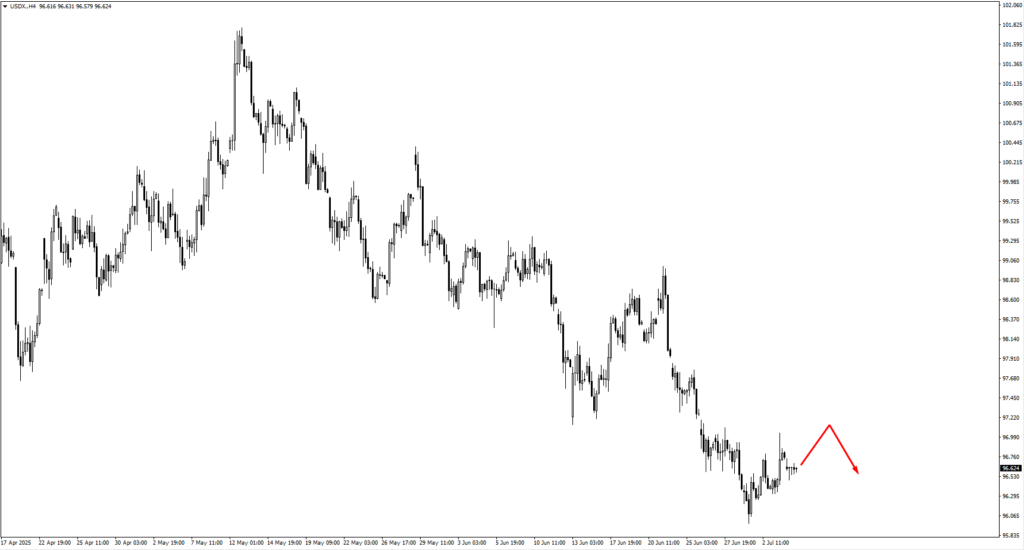
The US Dollar Index (USDX) remains in a coiling pattern. Price continues to consolidate, showing neither conviction from bulls nor bears. The next pivot is clear: 97.25. If the price climbs and stalls there, it sets the stage for a reversal. But if it pushes past and closes decisively above, then all eyes will shift higher, to 97.70, where another key resistance awaits. Until then, it’s a market in limbo.
EURUSD has crept upward from the 1.1720 zone, but the bulls don’t seem confident. Momentum is thin, and hesitation reigns. Should the pair slide further, traders will be waiting around 1.1700 for a bounce. If the price closes strongly below that level, the next test drops to 1.1660, a key floor that could either hold the line or give way to deeper losses.
GBPUSD is playing a similar game. The pair is caught in a tight range, consolidating as traders brace for Friday’s UK GDP print. If the pound slips, the 1.3520 area becomes the first line of defence. If that fails, 1.3415 is next in line, a level with history, where buyers are likely to make themselves known.
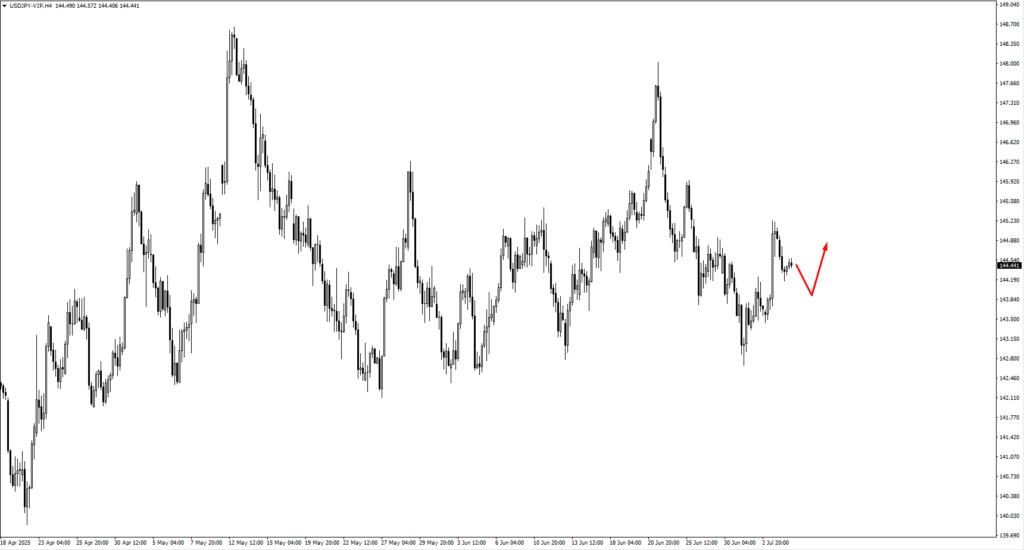
In the East, USDJPY began retracing just shy of the monitored 145.50 area. If selling intensifies, bullish price action is expected around 143.85 and 143.60. Both zones are strong historical reaction points, deep enough to attract buyers but close enough to remain in the current trend’s orbit.
USDCHF continues to edge lower, and buyers are watching the 0.7915 level for potential re-entry. If the pair turns upward instead, the 0.8050 region becomes the next key decision point. With the Swiss franc’s sensitivity to global uncertainty, volatility around these levels could intensify without warning.
AUDUSD is locked in a consolidation pattern, hovering just below recent highs. Should price dip further, traders are watching 0.6515 for a bullish reaction. The Reserve Bank of Australia’s next rate call looms, and with it, potential fireworks.
In New Zealand, NZDUSD bounced off the 0.6045 support zone but did so without much conviction. Bulls haven’t committed. If price rolls over again, the 0.6015 and 0.6000 zones are the next lines of interest, psychological levels where buyers may take a stronger stance.
USDCAD is drifting upward, approaching the 1.3650 area. Traders are on alert for bearish signals here, as the pair nears exhaustion. If the previous 1.35393 swing low is taken out after that, it would confirm momentum is fading and hint at deeper retracements to come.
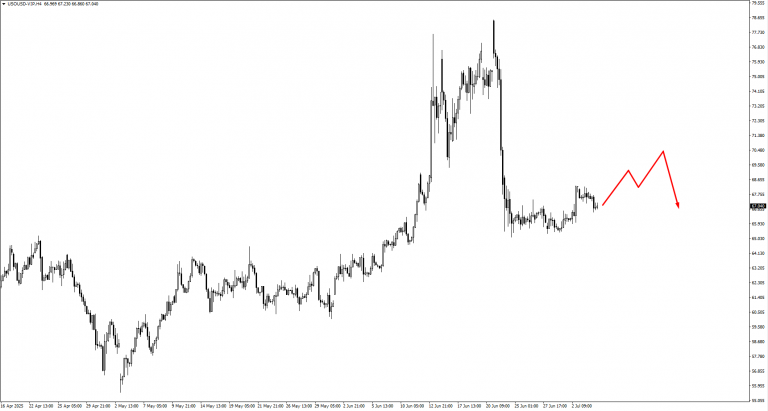
Commodities are faring no better under the spotlight. USOil (WTI) is slipping from recent highs. If it starts consolidating again, traders are watching for bearish reactions around 71.80 and 73.40. If those levels hold, a decline toward 63.35 or even 61.00 is possible. That slide would be steep and consequential for inflation forecasts.
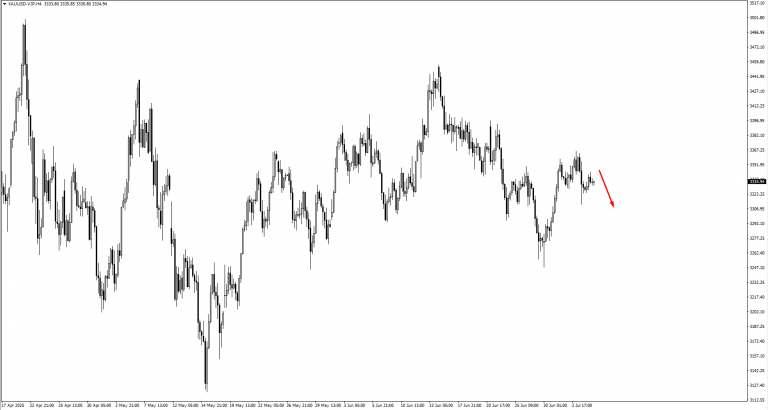
Gold is surging again, now approaching the 3350 resistance. If price stalls there and reverses, the 3300 level becomes key for bulls seeking re-entry. With real yields in flux and inflation chatter back on desks, gold may be setting up for another move, but the range is getting tighter.
Over in equities, the S&P 500 continues to ride a wave of bullish momentum, but cracks are beginning to form. With the U.S. tariff moratorium nearing expiry, some traders expect a retracement. If it climbs, 6400 and 6630 are the next resistance zones, both heavy with confluence, both ready to test the strength of the rally. Caution is warranted.
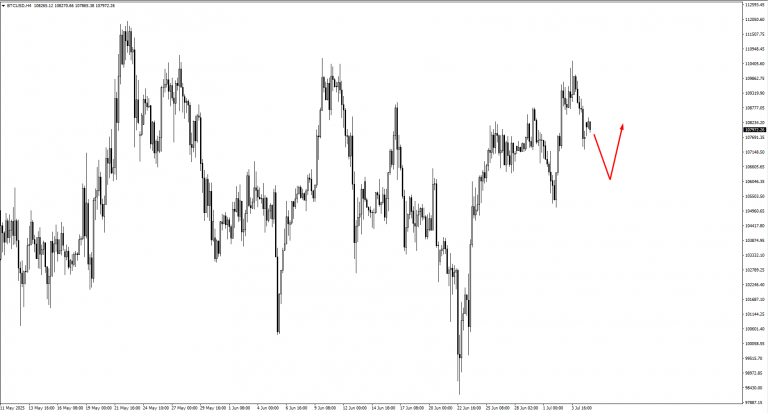
Bitcoin dropped hard from the 109,650 monitored level. It’s still bleeding. The next support is at 105,700, where traders expect a bullish reaction, at least temporarily. Crypto markets are jittery, and sentiment could turn quickly, especially if macro risks mount.
Natural gas has been particularly fragile. NG pulled back sharply from the 3.45 area. The immediate question is whether it can rebound to break above 3.75, or if it collapses further toward the 2.869 swing low. The current trend leans bearish, and price action this week has done little to inspire confidence.
Another chart for NG confirms it: buyers remain muted. If price drops again, watch the 3.09 area. A breakdown below that could trigger a steep slide, shaking out remaining longs.
Across the board, this is a market stretched thin. Charts are teetering near breakout and breakdown zones. Traders aren’t chasing highs blindly, but they aren’t selling in panic either. The sense is that something’s coming. The kind of week where tight stop-losses and clear discipline matter most.
Key Events of the Week
As we close out the week, the market’s pulse is now tied to three major events that could set the tone.
On Tuesday, July 8, the Reserve Bank of Australia’s cash rate decision is expected to set the tone for AUD pairs. Markets are pricing in a cut to 3.60% from the previous 3.85%, with expectations leaning toward a downward consolidation in AUDUSD early in the week. The signal is clear: traders are preparing for weaker Aussie momentum unless the RBA surprises with a more hawkish tone or a hold.
Wednesday, July 9, brings a double-header. The Reserve Bank of New Zealand is forecast to hold rates steady at 3.25%, and traders are advised to refer to the price structure rather than assume a breakout either way. Volatility could spike regardless, especially if forward guidance hints at economic softness or fiscal drag.
Wednesday also marks the end of the 90-day tariff reprieve for the U.S. This is the sleeper event of the week. If the U.S. fails to reach terms with major trading partners like the EU or Japan, traders could see fresh weakness in the US Dollar Index (USDX). Price may drift lower even before the deadline, pricing in the uncertainty, and if tensions escalate, it could tip major pairs into breakout zones.
Friday closes the week with a crucial UK GDP print. Monthly GDP is forecast to remain sluggish, following a prior reading of -0.3%, and cable (GBPUSD) will likely test structural levels if this contraction holds. Traders should brace for whipsaws if the figure deviates significantly from expectations.
Tesla’s market share in China drops as local competitors unveil innovative features and fast-charging technology
Dividend Adjustment Notice – Jul 07 ,2025
Dear Client,
Please note that the dividends of the following products will be adjusted accordingly. Index dividends will be executed separately through a balance statement directly to your trading account, and the comment will be in the following format “Div & Product Name & Net Volume”.
Please refer to the table below for more details:
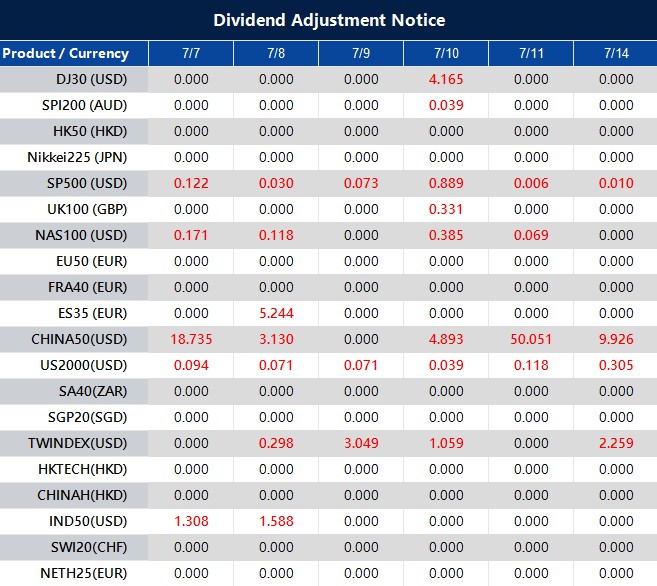
The above data is for reference only, please refer to the MT4/MT5 software for specific data.
If you’d like more information, please don’t hesitate to contact [email protected].




